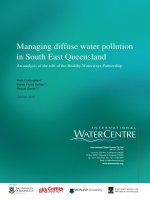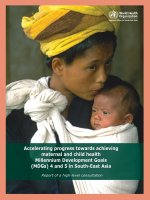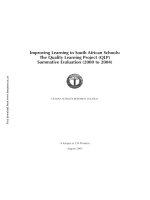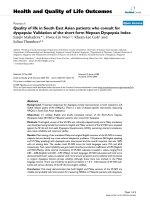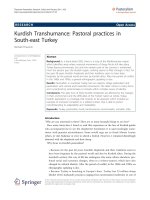Opium Poppy Cultivation in South East Asia pdf
Bạn đang xem bản rút gọn của tài liệu. Xem và tải ngay bản đầy đủ của tài liệu tại đây (9.63 MB, 154 trang )
Opium Poppy Cultivation
in South East Asia
October 2007
Central Committee for Drug
Abuse Control
Lao National Commission for Drug
Control and Supervision
Office of the Narcotics
Control Board
Lao PDR, Myanmar, Thailand
UNODC's Illicit Crop Monitoring Programme (ICMP) promotes the development and
maintenance of a global network of illicit crop monitoring systems in the context of the illicit crop
elimination objective set by the United Nations General Assembly Special Session on Drugs.
ICMP provides overall coordination as well as direct technical support and supervision to
UNODC supported illicit crop surveys at the country level.
The implementation of UNODC's Illicit Crop Monitoring Programme in South East Asia was
made possible thanks to financial contributions from the Government of Japan and from the
European Commission.
UNODC Illicit Crop Monitoring Programme – Survey Reports
These survey reports and other ICMP publications can be downloaded from:
www.unodc.org/unodc/en/crop_monitoring.html
Regional Reports
Coca Cultivation in the Andean Region 2006
Coca Cultivation in the Andean Region 2005
Coca Cultivation in the Andean Region 2004
Opium Poppy Cultivation in South East Asia
2007
Opium Cultivation in the Golden Triangle 2006
Country Reports
Afghanistan
Opium Survey 2007
Opium Survey 2006
Opium Survey 2005
Opium Survey 2004
Opium Survey 2003
Opium Survey 2002
Opium Survey 2001
Opium Survey 2000
Bolivia
Coca Cultivation Survey 2006
Coca Cultivation Survey 2005
Coca Cultivation Survey 2004
Coca Cultivation Survey 2003
Coca Cultivation Survey 2002
Colombia
Coca Cultivation Survey 2006
Coca Cultivation Survey 2005
Coca Cultivation Survey 2004
Coca Cultivation Survey 2003
Coca Cultivation Survey 2002
Coca Cultivation Survey 2001
Lao PDR*
Opium Survey 2005
Opium Survey 2004
Opium Survey 2003
Opium Survey 2002
Opium Survey 2001
Opium Survey 1999/2000
Morocco
Cannabis Survey 2005
Cannabis Survey 2004
Cannabis Survey 2003
Myanmar*
Opium Survey 2005
Opium Survey 2004
Opium Survey 2003
Opium Survey 2002
Peru
Coca Cultivation Survey 2006
Coca Cultivation Survey 2005
Coca Cultivation Survey 2004
Coca Cultivation Survey 2003
Coca Cultivation Survey 2002
Coca Cultivation Survey 2001
* Country reports from 2006 onwards are included in regional publications.
The boundaries, names and designations used in all maps in this document do not imply official
endorsement or acceptance by the United Nations.
This document has not been formally edited.
CONTENTS
PART 1 REGIONAL OVERVIEW 3
PART 2 THE IMPACT OF OPIUM POPPY ELIMINATION ON RURAL LIVELIHOODS
INTRODUCTION 13
COPING WITH CHANGE IN THE WA REGION: A CASE STUDY FROM MYANMAR 15
PART 3 LAOS OPIUM SURVEY 2007
EXECUTIVE SUMMARY 27
INTRODUCTION 29
FINDINGS 31
METHODOLOGY 41
PART 4 MYANMAR OPIUM SURVEY 2007
EXECUTIVE SUMMARY 51
INTRODUCTION 59
FINDINGS 61
METHODOLOGY 97
PART 5 THAILAND OPIUM SURVEY 2007
INTRODUCTION 123
FINDINGS 125
METHODOLOGY 134
PREFACE
The Golden Triangle is closing a dramatic period of opium production. Thailand has been opium-
free for a long time. Vietnam is also opium-free. Laos has cut opium production by 94% in less
than a decade (down to 1,500 hectares). Myanmar’s share of the world opium market has
collapsed from 30% in 1998 to under 6% in 2007. A decades long process of drug control is
clearly paying off. Thailand, in particular, stands out as an inspiration to its neighbours and a role
model for other countries trying to overcome their drug problems.
Yet it is too early to declare the drug problem in Southeast Asia as over. In 2007, opium
cultivation in Myanmar rose by 29% while production was up 46% thanks to higher yields. These
increases are dwarfed by the opium boom in Afghanistan, that produces 20 times more drugs than
Myanmar. But they flash a warning sign that reminds us that Myanmar is still, by far, the world’s
second largest opium producer (at 460 tonnes). Myanmar needs a more effective counter narcotics
strategy and more assistance, if it is to reach its target of being opium free by 2014.
The situation is particularly worrisome in the South Shan State. Although access for our ground
surveyors was difficult, there are signs of significant opium cultivation in this region.
Furthermore, there is evidence that double cropping, irrigation and fertilization are resulting in
higher yields than in other parts of the country. As in parts of Afghanistan and Colombia where
drugs and insecurity overlap, various groups are taking advantage of the situation in the South
Shan State to profit from instability.
More rural development assistance is essential to reduce the vulnerability to cultivate drugs
stemming from poverty. Ridding the Golden Triangle of opium, which has taken a generation,
could be quickly undone if farmers see no improvement in their living standards. In Laos, for
example, as opium production has fallen, prices have gone up – by 500% in the past five years.
Returning to opium is a serious temptation in poor communities which have yet to see the benefits
of abandoning poppy.
Opium growing regions would also benefit from improved drug treatment in order to cope with
disproportionately high rates of addiction.
The signs from South East Asia have been encouraging over a number of years. But there is no
guarantee that progress can be sustained over time. To consolidate the gains made until recently,
national governments and all stakeholders in an opium-free region need to continue their
engagement. The Golden Triangle should not be forgotten now that it is no longer notorious.
Antonio Maria Costa
Executive Director
UNODC
PART 1. REGIONAL OVERVIEW
1
FACT SHEET - SOUTH EAST ASIA OPIUM SURVEYS 2007
2006 2007 Variation
Opium poppy cultivation
1
Of which Lao PDR
Thailand
2
Myanmar
24,157 ha
2,500 ha
157 ha
21,500 ha
29,405 ha
1,500 ha
205 ha
27,700 ha
+22%
-40%
+31%
+29%
Weighted average dry opium yield
Lao PDR
Thailand
Myanmar
8 kg/ha
15.6 kg/ha
14.6 kg/ ha
6 kg/ha
15.6 kg/ha
16.6 kg/ha
-25%
0%
+14%
Potential production of dry opium
1
Of which Lao PDR
Thailand
Myanmar
337 mt
20 mt
2.4 mt
315 mt
472 mt
9.2 mt
3.2 mt
460 mt
+40%
-54%
+25%
+46%
Opium poppy eradication
Of which Lao PDR
Thailand
Myanmar
5,641 ha
1,518 ha
153 ha
3,970 ha
4,647 ha
779 ha
220 ha
3,598 ha
-18%
-49%
+44%
-9%
Average price of dry opium
Lao PDR
Thailand
3
Myanmar
US$ 550 /kg
US$ 1015 /kg
US$ 230 /kg
US$ 974 /kg
US$ 1,071 /kg
US$ 256 /kg
+77%
+6%
+15%
Total potential value of opium production
Of which Lao PDR
Thailand
Myanmar
US$ 85.4 million
US$ 11 million
US$ 2.4 million
US$ 72 million
US$ 132.5 million
US$ 8.9 million
US$ 3.6 million
US$ 120 million
+55%
-19%
+50%
+67%
Households involved in opium poppy cultivation
Of which Lao PDR
Thailand
Myanmar
133,600
5,800
1,300
126,500
n/a
1,600
163,000
n/a
+23%
+29%
Yearly income of opium poppy growing
households Lao PDR
Thailand
Myanmar
Of which from opium sale
Lao PDR
Thailand
Myanmar
n/a
US$ 300
US$ 437
n/a
US$ 30
US$ 217
n/a
n/a
US$ 501
n/a
n/a
US$ 227
n/a
n/a
+15%
n/a
n/a
+5%
Addiction rate in opium poppy growing regions
Lao PDR
Thailand
Myanmar
4
0.58%
n/a
0.60%
0.58%
n/a
0.75%
0%
n/a
n/a
1
These figures differ slightly from those published in the World Drug Report 2007, which subsumes
Thailand under the category of "other countries".
2
Source: Government of Thailand.
3
Increase due to change of currency exchange rate. In the local currency Thai Baht, prices did not
change significantly.
4
Surveyed areas of 2006 and 2007 are not comparable.
Opium Poppy Cultivation in South East Asia 2007
2
Map 1: Opium poppy cultivation in South East Asia (hectares), 2004 - 2007
Opium Poppy Cultivation in South East Asia 2007
3
REGIONAL OVERVIEW
In order to assess the scope of opium poppy cultivation and opium production, UNODC has been
carrying out opium surveys in cooperation with Governments. These collaborative surveys have
been undertaken in Lao PDR since 1992 and in Myanmar since 2002. Thailand has established its
own monitoring system. This report contains the results of the UNODC supported opium poppy
cultivation surveys in Lao PDR and Myanmar as well as results from the opium poppy surveys
implemented by the Thai Office of the Narcotics Control Board (ONCB).
Opium poppy cultivation in South East Asia
Opium cultivation in South East Asia takes place mainly in Lao PDR, Myanmar and Thailand.
Eradication figures reported by the Government of Viet Nam indicate that only a negligible
amount of opium poppy is cultivated there. Opium poppy cultivation in Lao PDR, Myanmar and
Thailand combined has decreased from an estimated 157,900 hectares
5
in 1998, the year of the
United Nations General Assembly Special Session on Drugs, to only 29,400 hectares in 2007.
Despite a 22% increase in 2007, this corresponds to an 81% overall reduction in only nine years. If
this decrease can be sustained in the future, it will be a remarkable, and unprecedented, success
and an important step toward the goal of eliminating the cultivation of illicit crops worldwide.
Figure 1: Opium poppy cultivation in South East Asia (hectares), 1998 – 2007
Hectares
0
20,000
40,000
60,000
80,000
100,000
120,000
140,000
1998 1999 2000 2001 2002 2003 2004 2005 2006 2007
Lao PDR Myanmar Thailand
The largest reduction in absolute terms has taken place in Myanmar where opium poppy
cultivation decreased by 83% in nine years from 130,300 ha in 1998 to only 21,500 ha in 2006.
Following six straight years of decrease, cultivation increased by 29% in 2007 to 27,700 ha. In
Lao PDR, the area under opium poppy decreased from 26,800 ha in 1998 to 2,500 ha in 2006 and
further in 2007 to only 1,500 ha. This is a reduction by 94% between 1998 and 2007, the largest
proportional reduction among the three countries. Thailand reported a reduction of its opium
poppy cultivation area from 1,486 ha in 1998 to only 157 ha in 2006 (-89%) but has observed a
slight increase to 207 ha in 2007. Lao PDR and Thailand have reduced cultivation to such an
extent that opium production is negligible and no longer finds its way to international markets.
5
Source: UNODC, World Drug Report 2007.
Opium Poppy Cultivation in South East Asia 2007
4
Figure 2: Global opium poppy cultivation (hectares), 1990 - 2007*
0
50,000
100,000
150,000
200,000
250,000
300,000
1990
1991
1992
1993
1994
1995
1996
1997
1998
1999
2000
2001
2002
2003
2004
2005
2006
2007
H
ec
t
ares
Afghanistan Myanmar Lao PDR Rest of the World
* Data for 2007 for Rest of the World are based on preliminary estimates.
Total area under opium poppy cultivation in Myanmar remains second only to Afghanistan. The
country's share of the global opium poppy cultivation fell from 55% in 1998 to only 11% in 2006,
before increasing slightly to 12% in 2007. Lao PDR, which in 1998 still had an 11% share of the
global opium cultivation, now accounts for less than 1%. In 2003, South East Asia has ceased to
be the largest opium poppy cultivating region. Its share of the world opium cultivation fell from
67% in 1998 to under 13% in 2007.
Opium poppy farmers in Laos, Myanmar and Thailand are ethnically diverse and live in remote,
mountainous regions. In these upland areas, difficult agricultural and geographic conditions
contribute to high levels of poverty. Opium poppy is currently cultivated in Kachin, Kayah and
Shan States in Myanmar, in the five northern-most provinces of Lao PDR and in the 10 northern
provinces of Thailand. Over the last fifty years or more, those regions have produced most of
South East Asia’s opium. Motivated by development and poverty alleviation objectives, the
Governments of Lao PDR, Myanmar and Thailand each committed to end opium cultivation in
these areas (by the year 2000 for Thailand, by 2006 for Lao PDR and by 2014 for Myanmar). So
far, Lao PDR and Thailand are on the verge of accomplishing this.
Eradication
Official reports from the Governments of Lao PDR, Myanmar and Thailand indicate that a total of
4,647 hectares of opium poppy were eradicated in 2007. This is significantly lower than in 2006
when 5,641 ha where eradicated. A total of 779 ha (50% of cultivated opium poppy) were
eradicated in Lao PDR, 3,598 ha in Myanmar and 220 ha in Thailand.
Opium Poppy Cultivation in South East Asia 2007
5
Map 2: Opium poppy eradication in South East Asia (hectares), 2004 - 2007
Opium Poppy Cultivation in South East Asia 2007
6
Opium yield and production
Opium poppy cultivation in South East Asia takes place mainly on steep hills with poor soil and
no irrigation facilities. Opium yields are much lower than in Afghanistan where the crop is often
cultivated on good soil and irrigated land. In 2007, opium yields were estimated at 6 kg/ha in
Laos, 16.6 kg/ha in Myanmar and 15.6 kg/ha in Thailand.
Total potential opium production in South East Asia decreased from an estimated 1,435 mt in
1998
6
to only 337 mt in 2006, before increasing to 472 mt in 2007. In spite of this increase, opium
production has fallen by 67% compared to 1998. South East Asia's Golden Triangle, which
produced 33% of the world opium production in 1998, now produces only about 5%. The once
notorious Golden Triangle has ceased to play a major role as an opium production area and this
region can no longer be called Golden Triangle on the reason of opium production alone.
Figure 3: Opium production in South East Asia (metric tons), 1998 - 2007
Metric tons
0
200
400
600
800
1000
1200
1400
1998 1999 2000 2001 2002 2003 2004 2005 2006 2007
Lao PDR Myanmar Thailand
In 2007, due to increases in opium poppy cultivation area and higher opium yields in Myanmar,
total potential opium production in this region increased by 40% over 2006. Although Myanmar
remains the second largest opium producer worldwide, its share of the global opium production
fell from 30% in 1998 to 5% in 2007.
6
Source: World Drug Report 2007.
Opium Poppy Cultivation in South East Asia 2007
7
Map 3: Opium production in South East Asia (metric tons), 2004 - 2007
Opium Poppy Cultivation in South East Asia 2007
8
Figure 4: Global opium production (metric tons), 1990 - 2007*
0
1,000
2,000
3,000
4,000
5,000
6,000
7,000
8,000
9,000
1990
1991
1992
1993
1994
1995
1996
1997
1998
1999
2000
2001
2002
2003
2004
2005
2006
2007
Metric tons
Afghanistan Myanmar Lao PDR Rest of the World
* Data for 2007 for Rest of the World are based on preliminary estimates.
Opium prices
Opium prices in South East Asia have increased over the past years and there are pronounced
price differences between countries as well as between regions within these countries.
7
In 2007,
the average price for one kilogramme of dry opium was highest in Thailand and Lao PDR with
prices of US$ 1,000/kg and US$ 974/kg, respectively, and, similar to previous years, lowest in
Myanmar (US$ 265/kg at the farm-gate).
The 500% price increase in Laos between 2002 and 2007 reflects the scarcity of opium in the
country, which is now a net importer. In Myanmar, by far the largest producer, prices rose as well
but much slower than in the rest of the region. The price for opium in Myanmar at the farm-gate
more than doubled from US$ 115/kg to US$ 265/kg from 2002 to 2007. Prices in Thailand
remained at a comparatively high level of over US$ 1000/kg for the third year in a row.
7
The level of transaction for opium prices in Lao PDR, Myanmar and Thailand is not easy to
determine, which makes a direct comparison of prices difficult.
Opium Poppy Cultivation in South East Asia 2007
9
Figure 5: Opium production and prices in producing areas in Lao PDR, Myanmar, and
Thailand, 2002 – 2007
Metric tons
0
100
200
300
400
500
600
700
800
900
2002 2003 2004 2005 2006 2007
US$/kg
0
200
400
600
800
1,000
Lao PDR Production Myanmar Production Myanmar Price
Thailand Price Lao PDR Price
Household income from opium
The contribution of opium sales to the household income of farmers varies considerably
throughout the region. In Myanmar, opium sales constitute about half of the annual household
cash income and are mainly used to cover food shortages. In Laos and Thailand, income from
opium represents only 10% of the household cash income.
Higher opium prices in 2006 pushed incomes of opium poppy farmers up by 50% over the
previous year. In Myanmar, 43% of the average annual household income (US$ 437) of opium
cultivating households came from opium sales in 2006 in contrast with 10% of US$ 300 annual
cash income in Thailand. With such a large proportion of the household cash income generated by
opium, farmers in Myanmar are vulnerable to opium price fluctuations and decreases in
production caused by drought, disease or law enforcement. These income fluctuations have a
serious and immediate impact on household food security. In Special Region 2 (Wa) in Myanmar
where local authorities enforced an opium ban in 2005, farmers lost up to 70% of their cash
income. In Laos, where opium cultivation was at lower levels and elimination has been more
gradual, farmers are better off in terms of food security. In Thailand, opium elimination has taken
place over more than 30 years and sufficient alternative livelihood promotion and programmes
have accompanied this process, thereby developing and increasing the range of income sources
available to farmers.
Opium Poppy Cultivation in South East Asia 2007
10
Map 4: Prices of dry opium in South East Asia (US$/kg), 2007
Opium Poppy Cultivation in South East Asia 2007
11
Opium abuse
In South East Asia, opium addiction is mainly found in places where opium poppy is cultivated.
Since opium cultivation has declined rapidly in the last five years, the cost of opium has increased
greatly. This has encouraged, or forced, many users to try to stop smoking opium, either by self-
treatment or through treatment programmes. The number of opium addicts in Lao PDR declined
from 11,200 in 2006 to only 7,700 addicts in 2007, a reduction of over 30%. The addiction rate
decreased similarly from 0.58% to 0.30%. In Myanmar, opium addiction remains high at 0.75%.
In Thailand, opium and heroin addiction have largely become urban problems. Very few opiates
abusers are reported by the Thai Government.
The impact of opium poppy elimination on rural livelihoods
Rural households that abandoned opium poppy cultivation have reported both positive and
negative changes as a result. Positive impacts include the rehabilitation of addicts, lightening of
women’s workload, and the opportunity to diversify out of an unreliable and illicit cash crop.
Negative impacts include shortage of food and cash, increased debt and higher levels of stress.
Predictably, a vulnerability analysis of farmers in Myanmar living in areas where opium has been
banned showed a limited impact on living conditions for non-opium poppy farmers, and a more
serious impact on ex-opium farmers. Within both groups there were farmers who have coped more
or less successfully than others in dealing with the changes caused by the ban.
In terms of coping strategies, some ex-opium poppy farmers have developed alternative means of
income by working as casual labourers, selling livestock, collection of non-timber forest products
and diversification of agricultural activities, such as rubber tree and tea cultivation. However, not
all of these strategies are economically or environmentally sustainable, and as a result farmers in
difficulty have been forced to borrow money or reduce their expenditures by limiting their
household’s access to food, health facilities, education and primary needs. This has contributed to
a deterioration of their living conditions, their debt has increased and there is little opportunity for
them to generate new income in the absence of external capital.
For non-opium poppy farmers, who were already engaged in non-opium income generation
activities and who possessed some material assets, such as livestock, land and a good level of food
security, the opium ban has had little, if any affect on their situation. However, there still exists a
group of non-opium poppy farmers who are in a very vulnerable situation due to insufficient levels
of income, which has worsened after the ban due to the lack of casual employment opportunities
in the opium poppy fields.
Today, the needs of vulnerable farmers are so great that the level of assistance provided thus far
has been insufficient. Emergency aid and sustainable development programs are urgently needed
to support farmers in the development of alternative livelihoods. This will be crucial to preventing
out-migration of the people and the resumption of opium poppy cultivation.
PART 2. THE IMPACT OF OPIUM POPPY ELIMINATION
ON RURAL LIVELIHOODS
13
1 INTRODUCTION
The Golden Triangle is known throughout the world as an important centre where opium poppy
has been cultivated and marketed for centuries. The town of Sop Ruak, at the Lao-Myanmar-Thai
border, along the Mekong River, is thought to be the centre of the region and known informally as
the Golden Triangle. Often, the Golden Triangle is perceived as a lawless area where warlord
gangs fight with each other over caravan routes and markets.
Almost everything about this image is false. While parts of the Golden Triangle might be beyond
the effective control of national Governments, most of the people in the area are not drug
traffickers, but poor farmers who cannot grow enough food to support themselves. Sop Ruak has
only been called the “Golden Triangle” since the 1980s.
Some thirty years have elapsed since the term “Golden Triangle” was reportedly first used by
Marshall Green, United States Assistant Secretary of State. At a press conference in July 1971,
Green said that drugs were spreading through a “golden triangle” encompassing Laos, Burma
(Myanmar), and Thailand. By referring to this region as a triangle, Green implicitly recognized the
absence of opium cultivation and use in China.
At that time, United States and Thai leaders were planning the implementation of an illicit crop
replacement project in northern Thailand. When the Crop Replacement and Community
Development Project started operations in 1971, it became the first such activity of the then newly
created United Nations Fund for Drug Abuse Control (UNFDAC), a predecessor organization to
UNODC.
By the 1970s, intensive cash-cropping of opium poppy was little more than a century old. Before
that time, opium was not a cash crop and mostly grown in backyard gardens, for use as a
medicinal substance in treating pain, dysentery, cough, and the symptoms of malaria.
This changed after British gunboats attacked Chinese coastal towns in the mid-nineteenth century
to force China to open the country to the sale of opium that it had banned because opium addiction
among the Chinese population had reached problematic levels. Once gaining access to this
potentially huge Chinese market, British merchants hoped to sell opium grown in British-
controlled Bengal for huge profits. Both because China’s Ching Dynasty was weakening at this
time and because of superior British gunboat firepower, the Chinese could not resist. The so-called
Opium Wars of 1839-1842 and 1856-1860 ended with the legalization of the opium trade in
China. However, British hopes of exporting Bengal opium to China did not fully materialize.
Chinese entrepreneurs realized that opium was already being grown in the hills of southern
provinces of China and promoted opium poppy cultivation by the ethnic minorities as a cash crop
for export elsewhere in China.
Eventually, many people living in southern China migrated southwards into British Burma,
Thailand, and French Indochina as unrest spread in the late nineteenth, early twentieth century. As
they moved, so did the opium trade. Colonial and Thai administrators generally welcomed the
income that could be derived from this trade to administer their respective countries. The move of
opium cultivation southwards accelerated after 1949. Several campaigns in the early-1950s
eliminated opium cultivation in southern China, leading to large-scale crop displacement from
southern China to some provinces in Burma as well as Laos, Viet Nam, and Thailand.
Only then did the Golden Triangle take shape as a major centre of opium cash cropping. In this
region there were several major cultivation centres. In Myanmar, these were the Wa Region and
Kokang, both along the China border in Shan State. In Laos, opium poppy was cultivated in the
northernmost province of Phongsaly and the eastern provinces of Xieng Khouang, particularly
Nonghet District and Xam Neua, as well as in adjacent areas in Viet Nam. Major growing areas in
Thailand were in Chiang Rai Province around two mountains, Doi Tung and Doi Mae Salong.
Large poppy fields were also cultivated in some villages just west and northwest of Chiang Mai
city.
For decades, there were no systematic estimates on opium poppy cultivation. This began to change
after the opium cultivation ban in Thailand which went into effect in 1958. In 1965/1966, the
Opium Poppy Cultivation in South East Asia 2007
14
Public Welfare Department of Thailand carried out a socio-economic survey of hill people in
opium poppy growing areas and in 1967, the United Nations Commission on Narcotic Drugs
financed a survey on socio-economic needs. The latter survey estimated cultivation of opium
poppy in Thailand to cover 18,500 hectares with an opium production of 145 tons. Soon,
alternative development projects were implemented by the government as well as by international
agencies including UNFDAC. This and the strong political commitment of the Government of
Thailand resulted in significant reductions in cultivation levels. By 1984, Thailand had become a
net importer of opium.
Civil unrest and warfare in the other opium poppy growing countries of the Golden Triangle
prevented opium surveys and development work until the late 1980s. However, from then on,
increased political will as well as the implementation of various development projects contributed
to the reduction of opium cultivation in Laos and Myanmar. Although opium poppy is still
cultivated in the so called Golden Triangle, other trades are overtaking the opium business and its
reputation is slowly changing for the better. Two out of three countries of the so called Golden
Triangle, Lao PDR and Thailand, are on the verge of becoming virtually free of opium poppy
cultivation.
Opium Poppy Cultivation in South East Asia 2007
15
2 COPING WITH CHANGE IN THE WA REGION:
A CASE STUDY FROM MYANMAR
Opium poppy cultivation has decreased dramatically in South East Asia over the last decade due
to the enforcement of opium elimination policies by the respective governments. However, the
strategies employed and the conditions, under which these opium elimination policies were
implemented, differed from country to country, as well as from region to region within these
countries. This case study looks at the impact of the introduction of an opium ban in the Wa
Special Region 2 in eastern Myanmar in 2005. The Wa region, which is part of Shan State, used to
be the main opium poppy cultivation region in the country until the enforcement of the ban.
In June 2005, a complete ban on the trade of opium and cultivation of opium poppy entered into
force in the Wa region, and in the same year the region was declared opium free. The introduction
of the opium ban provides an opportunity to study the impact of opium elimination on the socio-
economic situation of households and villages in the Wa region. Furthermore, the lessons learned
from this case study may be of assistance when preparing the introduction of similar bans in other
regions – especially with regards to designing coping strategies for ex-opium poppy farmers to
deal with the impact of the ban.
The following is a summary of the opium ban’s impact in Wa Special Region 2, and is based on
both quantitative and qualitative analysis.
8
Collecting base line data
8
All quantitative and qualitative data used in this chapter are based on the following report:
Northern Wa Region: Socio-economic and vulnerability analysis of Naung Khit, Nam Kham Wu,
Man Man Hsain and Kong Ming Sang Townships. UNODC Wa project, Myanmar 2007.

